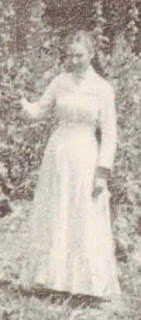My paternal great-grandmother, Ollie Johnson Utter Brier, married Bill Brier in 1921. The Brier family immigrated from Germany and settled in Kansas. Bill’s parents, Herman and Dora (Dettmer), and their many family members came to the United States in the 1880s and settled around Liberal and Emporia in Southwestern Kansas. This photo shows Bill holding a child and members of his family.
The Dettmer family left Hamburg, Germany, on the ship Wieland in February 1885 and arrived in New York in March. The Briers came around that same time. Coming to
America on the great steamers was a hope-filled trip for those who crossed the
waters to land in New York on American soil. Finding those records of your
family who sailed to America can be daunting and time-consuming.
Bill’s parents were farmers and acquired an abundance of land. They raised mainly wheat. Herman Brier died from consumption when he was 27 years old. He left his wife and three children, Anna, Bill, and Edward. Dora remarried eleven years later.
I found the families using genealogical records, Newspapers.com, and Find a Grave online. Most of them farmed the land, some owned businesses, especially restaurants, and most of the men who were able fought in the Great War. A few of their friends never came home from France.
The Briers and Dettmers were exceptionally social, attending various community events. Newspaper accounts talk about their active lives; they were constantly out and about doing charitable deeds in the community and visiting friends.
Bill’s
sister, Anna, was a schoolteacher in Liberal, Kansas. She had many friends and
enjoyed social events with her Brier and Dettmer cousins, Anna Mae, Dora, Mary,
Clara Hammontree, and others. Anna married Grant Webber in a double ceremony
with her brother, Edward, on June 1, 1914. She had two children. Grant died
four years after marriage, and she remarried Albert McLeod. She and
Great Grandma Ollie held each other in high regard. I remember Anna and Albert.
We visited them on their Kansas farm in Sublette. Anna and Al came to visit me
in Neosho, Missouri. I have letters that she wrote telling me about her family
history. Anna died in 1979. Here is a photo of Anna.
Clara Hammontree married Edward Brier in a double wedding ceremony with his sister, Anna, on June 1, 1914. They had five children. Ed died in 1930, and Clara married again in 1931. In this photo, Grandma Ollie is the woman on the left, Clara, and unknown. Bill is bottom left, and Ed is on the right.
The Hammontrees were socialites from Arkansas who moved to Kansas at the turn of the century. There, Ed met Clara. Ed joined the Navy at the same time Bill did. Ed and Bill were the “Brier Boys” in the community. They enjoyed outings and get-togethers. Here are photos of the family.
Lyla Brier married Frank Sprague and had three boys and one daughter. Her daughter, Louise Sprague, was a schoolteacher. She joined the Army in April 1943 and served as an aviation cadet in the Women’s Army Corps for four years. She never married and died in 1992 in Emporia, Kansas. This is Louise.
Anna Mae, Mary, and Dora Dettmer always helped, worked, and connected with the community in some way. Anna Mae Dettmer was a Red Cross nurse. She married Elijah Wright and had one son. Anna Mae died in 1980 in Liberal, Kansas. This is Anna Mae and her mother.
Dora Dettmer was a Kansas schoolteacher. She married Leonard Young; they had no children. She died in 1999 in Liberal, Kansas. This is Dora.
Anna Dettmer, an aunt of Anna Mae and Dora, married Dr. Howard Marsh. They had one daughter. Dr. Marsh died when he was 45. Anna never married again.
The
Modlin family were neighbors of my great-grandmother Ollie’s family in
Southwest Missouri and became great friends. Ollie’s sister married
William Modlin, and Lydia Modlin Fitzgerald remained friends with Ollie and Bill
Brier for years. Here are photos of Lydia, Ancil, and Bill.
Bill and Ollie loved baseball; he played for the town team in Liberal, Kansas. He was an aggressive player who played very well as a pitcher, fielder, first baseman, etc. In 1921, he was hailed as “The Babe Ruth” because he got a number of hits off the pitcher. Here is Ollie and Bill.
On
June 5, 1917, Bill, Ed, and many others registered for the military. The
newspapers reported it was a solemn day in the community as wartime efforts
began to build. Olive green armbands were distributed to those who came
for the food drives and Red Cross funds. The draft lists were updated in a
timely manner for those who were being called to the Great War. May 15, 1918, a
new draft list was released, Bill’s number was 470, so he enlisted in the
United States Navy the next day. Eight days later, the town gave the men a
sendoff with flags flying, a band playing, and prayers as they left for Kansas
City, Missouri. Bill served as a gunner’s mate in the Navy until January 30,
1919, when he received his discharge. Here are a few photos from my
great-grandmother’s collection.
Resources
Home - Kansas Historical
Society (kshs.org)
https://2nd-division.com/_div.units/17th.fa/17th.fa.media.htm#:~:tex
https://www.usmilitariaforum.com/forums
The 2nd Division A. E. F. — Chronology of the 17th Field Artillery (2nd-division.com)





















































